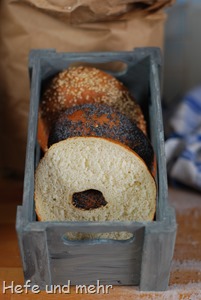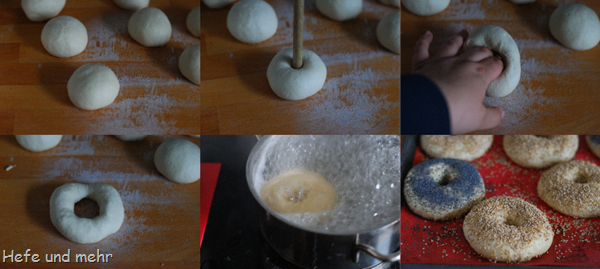 I was asked to include a bagel recipe in my little course about bread baking and I was very willing to do so. Bagels are a good recipe for beginners as the dough is quite firm and not sticky at all. Kneading on the other hand can be a little work out because of the firm dough, too. But kneading a bagel dough is important to get a chewy bagel. So turn on some music and start kneading!
I was asked to include a bagel recipe in my little course about bread baking and I was very willing to do so. Bagels are a good recipe for beginners as the dough is quite firm and not sticky at all. Kneading on the other hand can be a little work out because of the firm dough, too. But kneading a bagel dough is important to get a chewy bagel. So turn on some music and start kneading!
Another important point is boiling the bagels prior to baking. The longer you cook, the denser the bagel will become, as the proteins and starch on the outside of the bagel start already to set, preventing the bagel from rising to much in the oven. I like Bagel on the softer side, so I boil them for 30 seconds on each side. But play around with this time to get your personal perfect bagel!
To enhance the brown, shiny crust I added some baking soda to the boiling water. The soda makes the water mild alkali and this will effect the surface of the bagel. While cooking the bagels in this solution, some of the proteins are break down into their building blocks (amino acids). During baking, these amino acids will then react with the sugars in the crust (Maillard reaction) which then will lead to darker browning of the crust. The same effect is used when baking pretzels, but the lye used there is much stronger, which in the ends leads to a much stronger browning and the prominent flavour of real lye pretzels.
Bagel
yields 7 big Bagel or 8 small ones
Dough
- 500g flour Type 550
- 260g Water
- 10g fresh yeast
- 10g Salt
- 25g Butter
- 30g honey
For Boiling
- 1.5 l Water
- 15g Baking Soda
Topping
- poppy seeds
- Sesame
Knead all ingredients for the dough for 10 min by hand. The dough should be relatively firm and not sticky.
Ferment for 1 hour at room temperature or overnight in the fridge.
Divide the dough into 120g pieces for big bagels (or 100g for small ones) and form them to rings. The easiest way to do so, is first forming the dough pieces to balls (see here), then punch a wooden spoon through the middle and widen the ring by rolling the dough between your fingers. At the end you should be able to insert 4 fingers through the hole. Place the bagel on a sligthly floured tea towel, covering with a second one.
 Proof them for 1 hour
Proof them for 1 hour
Bring water with soda to boil and cook the cook them for 30 sec each side in boiling water.
Place the bagel on a baking sheet and sprinkle them with poppy seeds or sesame.
Bake at 250°C for 20 min (small Bagel has to be bake for about 16-18 min).
Deutsch



Hallo Stefanie,
Kann ich auch Mehl Typ 1050 verwenden? Wieviel Wasser muss ich dann nehmen? Ändert sich sonst noch etwas?
Vielen Dank vorab und liebe Grüße
@Tina: Der Unterschied zwischen 550er und 1050er Mehl ist nicht so groß, darum würde ich mit der Wassermenge im Rezept anfangen und nach Bedarf 10-20g Wasser gegen Ende der Knetzeit zugeben, wenn man sieht, ob der Teig noch mehr Wasser braucht oder nicht.
Vielen Dank Stefanie! Ich habe die Bagel gestern gebacken. Zusätzliches Wasser brauchte ich nicht. Waren super lecker! Meine Familie hat schon gefragt, wann ich das nächste Mal welche backe.
Wie funktioniert das kochen mit richtiger Lauge aus der Apotheke?
Stefanie
@Stefanie: Mit “richtiger” Natronlauge sollte man nur kalt arbeiten, da zum einen die Lauge durch das Kochen stärker wirkt, zum anderen ist die Gefahr, Laugenspritzer auf Hände, Gesicht oder Augen zu bekommen beim Kochen viel höher, ausserdem sind die heißen Laugendämpfe gefährlich und sollten nicht eingeatment werden! Sonst kann man sich die Schleimhäute von Mund, Nase und Augen verätzen!
Zum Kochen von Laugen-Bageln nimm bitte Kaisernatron o.ä., was eine deutlich schwächer Lauge ist und erst durch das Kochen richtig wirkt. Mit 50g auf einen Liter solltest du gut fahren.
Wie wichtig ist es, dass die geformten Bagel nach der Übernachtgare eine ganze Stunde gehen? Ich möchte die Bagel gern zum Sonntagsfrühstück machen und natürlich möglichst lange schlafen.
@Extramittel: Dann würde ich eher den Teig am Abend etwas früher kneten, 1 Stunde gehen lassen und formen. Die geformten Bagel auf ein Geschirrtuch (am besten Leinen) setzen und mit einem 2. Tuch abdecken und über Nacht im Kühlschrank bei 4°C gehen lassen. Dann musst du am Morgen nur noch die Bagel ins siedene Wasser geben und danach backen 🙂
würde man sie direkt nach dem Formen kochen, würde man eine sehr dichte, unregelmäßige Krume bekommen.
Hat jemand ein Rezept vonDonats. Danke
@Sigrid: Hefe- oder Backpulver – Doughnuts? Wenn du eine Hefe-Variante suchst, kann ich dir dieses oder dieses Berliner-Rezept empfehlen, nur muss für Doughnuts der Teig ausgerollt und Ringe ausgestochen werden.
Hallo und danke für das Rezept! Müssen die Bagel im Ofen bedampft werden (Schwaden) oder entfällt das durch das Kochen? Danke!
@Christoph: Durch das Kochen ändert sich die Oberflächenbeschaffenheit und man muss nicht Schwaden (also bedampfen).
Hallo,
eine Frage zur Hefe; kann auch Trockenhefe verwendet werden? Wenn ja, würde diese dann auf 5 g reduziert?
Vielen Dank für die tollen Rezepte!
Beste Grüße
@Rebecca: Wenn du Trockenhefe verwendest, reichen normalerweise 3-4g.
Do you bake the bagels after boiling in the oven? Thanks R
@Ray: I’m sorry, somehow the last sentence got lost. They are baked at 250°C for 20 min. I corrected the recipe accordingly!